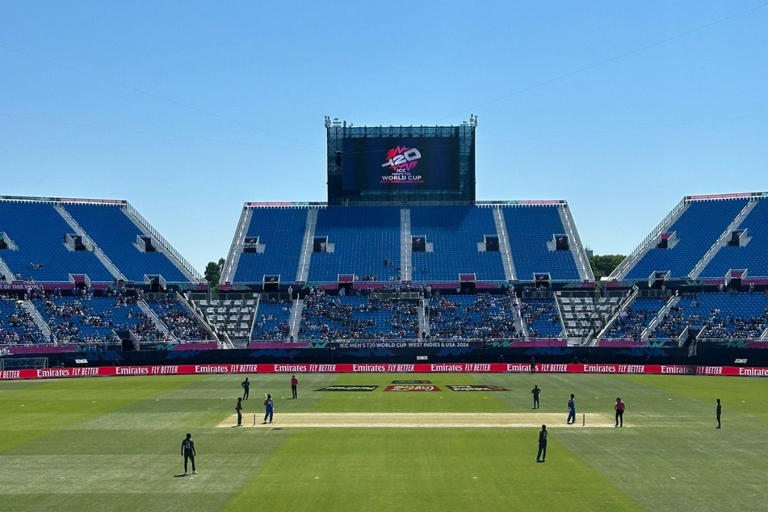What will happen to the difficult pitches at the Nassau County International Cricket Stadium? The response is simple. After being built in just 106 days, the Pop-Up Stadium will take about six weeks to disassemble. Such effort started on Wednesday, immediately following the afternoon conclusion of the India-USA match.
The muddy, grassy, and dusty surfaces of Eisenhower Park, which once held the stadium and was converted into a haven for the games and fans, will be open to the public at no cost. After being closely watched and limited for the previous two weeks, the entries will be open to anyone.
The Nassau stadium pitches’ future is still up in the air. The International Cricket Council (ICC) asserts that the decision rests with the authorities of Nassau County. “They can keep them if they want to and can manage the necessary maintenance,” an ICC representative stated. If not, the ICC will move the drop-in pitches, the topic of intense debate for the past two weeks, to where they will be required. The pitches were prepared in Florida using imported knowledge from South Australia. That being said, the outfield will stay where it is.
The Nassau stadium was to host a couple of Major League Cricket (MLC) matches. However, the MLC officials and their teams were relaxed about that idea. It seems doubtful that a full-fledged cricket stadium will exist here shortly, but it is possible. The Mumbai Indians (MI NY) play in Major League Baseball (MLB), and the Ambanis plan to construct a new stadium soon.

Simple to defend or pursue?
The community is perplexed whether the pitches, which have been the talk of the cricket world for the past two weeks, promote chasing or defending. On June 9, South Africa held off Bangladesh’s attack with their not-so-amazing score of 113, while India successfully defended a modest 119 against Pakistan. The following day, Pakistan quickly reached their target of 107 runs. On Wednesday, though, India found it difficult to chase 111 before Shivam Dube and Suryakumar Yadav gave Rohit Sharma’s team the victory.
In the eight games played at the venue, teams batting first have won three, while teams pursuing have won five. India achieved the most successful chase, reaching 111 for three against the USA, with an average first-inning total of 108. When batting first against Ireland, Canada scored the highest total (137 for 7) and played excellent defense to win the match by 12 runs.
Arshdeep Singh stayed silent when asked about the Nassau stadium pitch’s conditions, but Dube indicated he would rather chase, thus endorsing Rohit Sharma’s choice to field first against the United States.
Did the 5-run penalty make sense?
The USA team’s five-run penalty was the main topic of conversation during the game. After the bowling side missed their third opportunity to begin their over within the one-minute gap between overs, India gained from these extra runs. They received enough warning before the home team was subject to the “stop clock” disciplinary regulation. The regulation for international white-ball cricket was enacted in December of last year. After the second warning, five runs would be deducted from the bowling side for any violation.
At the end of the fifteenth, India was 76 for three, requiring 35 runs to win the final five overs. Due to the penalty, the target was changed to require exactly six runs per over in the last five overs. Similar circumstances occurred against Pakistan, and India just missed the penalty.
The penalties have sparked discussion over whether penalty runs were justified and whether the emphasis on finishing the game quickly detracted from the overall quality of the match. The American squad said it had nothing to do with their defeat.
“I believe that the play should have a tempo. In my opinion, it is excessive to extend games that are meant to last three and a half hours to four and a half hours. The purpose of the ICC is to impose laws and guidelines. It is our duty as coaches and teams to abide by these regulations. I’m sure the ICC will take action if enough people complain that it might hurt the game. “I don’t think it’s bad,” USA coach Stuart Law stated.
“The game keeps going forward. When the tide is in your favor, you want to maintain it faster and apply more pressure to the opponent. It’s not here nor there, then. Contrary to what many would say, I don’t think it impacted the game’s outcome. However, at that point, losing five runs was important. However, it could have taken us to the 19th or 20th over instead of concluding in the 18th (19th),” the Australians added.
What’s essential to notice is how the cricket world would have responded if India, winning by six wickets, had been fined five runs in those pivotal minutes of the June 9 match against Pakistan. Or what if the penalty on June 29 in Bridgetown, Barbados, decided who would win the World Cup?
Also Read : Vote! Who Could Win the T20 World Cup?
